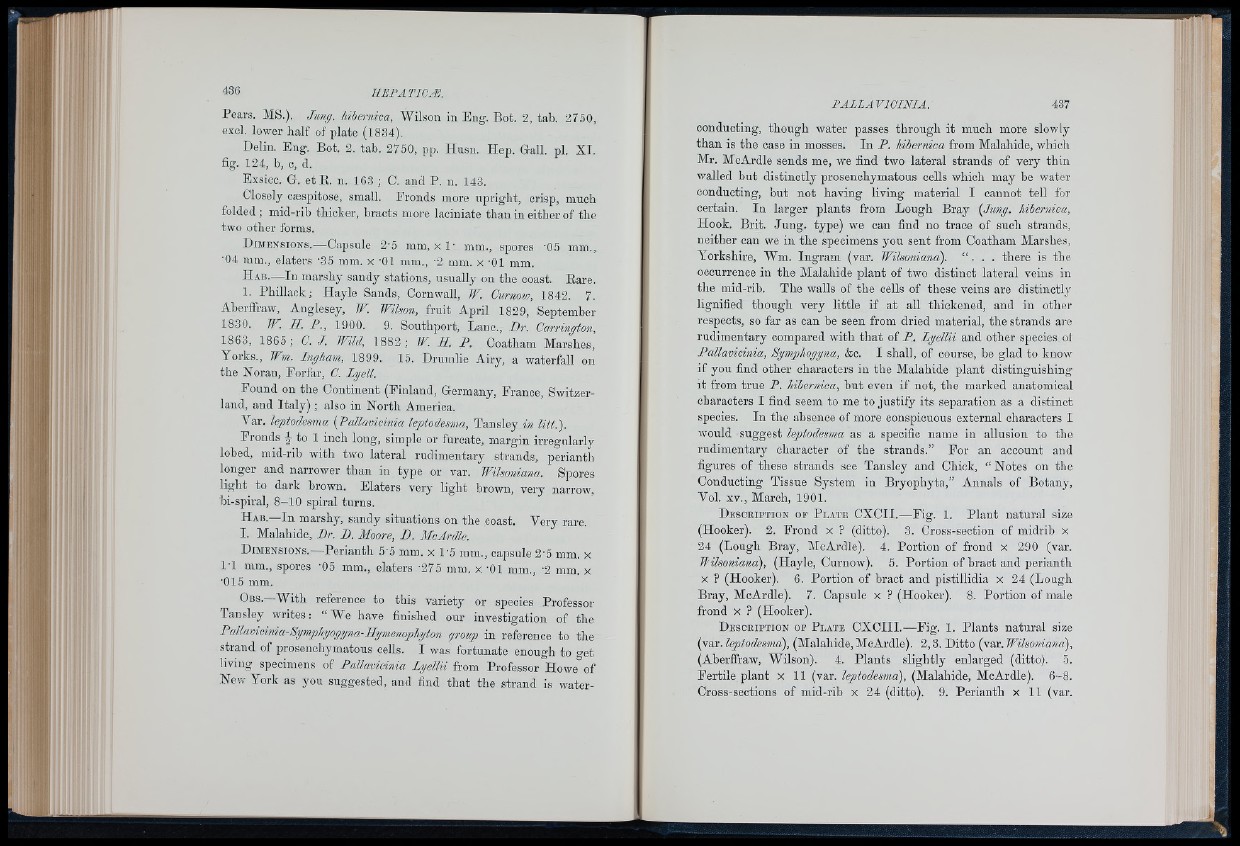
Pears. MS.). Jung, hibernica, Wilson in Eng. Bot. 2, tab. 2750,
exol. lower half of plate (1834).
Delin. Eng. Bot. 2. tab. 2750, pp. Husn. Hep. Gall. pi. XI.
fig. 124, b, 0, d.
Exsicc. G. e t li. n. 163 ; C. and P. n. 143.
Closely cæspitose, small. Pronds more upright, crisp, much
folded ; mid-rib thicker, bracts more laciniate than in either of the
two other forms.
D im e n s io n s .— Capsule 2’5 mm, x 1 ' m m ., sqiores '05 m m .,
■04 m m ., elaters '35 mm. x ’01 m m ., '2 mm. x '01 m m .
H ab.— I n marshy sandy stations, usually on the coast. Eare.
1. Phillack; Hayle Sands, Cornwall, W. Curnoto, 1842. 7.
Aberffraw, Anglesey. W. Wihon, fruit April 1829, September
1830. W. II. P., 1900. 9. Southport, Lane., Dr. Carrington,
1863, 1865; C. J. Wild, 1882; W. II. P. Coatham Marshes,
Yorks., Wni. Ingham, 1899. 15. Drumlie Airy, a waterfall on
the Noran, Forfar, C. Lyell.
Found on the Continent (Finland, Germany, France, Switzerland,
and Italy) ; also in North America.
Var. leptodesma {Pallavicinia leptodesma, Tansley in litt.).
Fronds J to 1 inch long, simple or furcate, margin irregularly
lobed, mid-rib with two lateral rudimentary strands, perianth
longer and narrower than in type or var. Wilsoniana. Spores
light to dark brown. Elaters very light brown, very narrow,
bi-spiral, 8-10 spiral turns.
H ab.—I n marshy, sandy situations on the coast. Very rare.
I. Malahide, Br. B. Moore, D. McArdle.
D imensions.— Perianth 5'5 mm . x 1'5 m m ., capsule 2’5 m m . x
1-1 m m ., spores '05 m m ., elaters '275 mra. x Al m m ., ‘2 mm . x
'015 mm .
Obs.—With reference to this variety or species Professor
Tansley writes: “ We have finished our investigation of the
Pallavicinia-Symphyogyna-Hymenophyton group in reference to the
strand of prosenchymatous cells. I was fortunate enough to o-et
living specimens of Pallavicinia Lyellii from Professor Howe” of
New York as you suggested, and find that the strand is waterconducting,
though water passes through it much more slowly
than is the case in mosses. In P. hibernica from Malahide, which
Mr. McArdle sends me, we find two lateral strands of very thin
walled but distinctly prosenchymatous cells which may be water
conducting, but not having living material I cannot tell for
certain. In larger plants from Lough Bray {Jung, hibernica.
Hook. Brit. Jung, type) we can find no trace of such strands,
neither can we in the specimens you sent from Coatham Marshes,
Yorkshire, Wm. Ingram (var. Wilsoniana). " . . . there is the
occurrence in the Malahide plant of two distinct lateral veins in
the mid-rib. The walls of the cells of these veins are distinctly
lignified though very little if at all thickened, and in other
respects, so far as can be seen from dried material, the strands are
rudimentary compared with that of P. Lyellii and other species ot
Pallavicinia, Symphoyyna, &e. I shall, of course, be glad to know
if you find other characters in the Malahide plant distinguishing
it from true P. hibernica, but even if not, tbe marked anatomical
characters I find seem to me to justify its seqiaration as a distinct
species. In the absence of more conspicuous external characters I
would suggest leptodesma as a specific name in allusion to the
rudimentary character of the strands.” For an account and
figures of these strands see Tansley and Chick, “ Notes on the
Conducting Tissue System in Bryophyta,” Annals of Botany,
Vol. X V ., March, 1 9 0 1 .
D escr iptio n of P late CXCII.—Fig. 1. Plant natural size
(Hooker). 2. Frond x ? (ditto). 3. Cross-section of midrib x
24 (Lough Bray, McArdle). 4. Portion of frond x 290 (var.
Wilsoniana), (Hayle, Curnow). 5. Portion of braot and perianth
X ? (Hooker). 6. Portion of bract and pistillidia x 24 (Lough
Bray, McArdle). 7. Capsule x ? (Hooker). 8. Portion of male
frond X ? (Hooker).
D escr iptio n op P late CXCIII.—Fig. 1. Plants natural size
(var. leptodesma), (Malahide, McArdle). 2,3. Ditto (var. Wilsoniana),
(Aberffraw, Wilson). 4. Plants slightly enlarged (ditto). 5.
Fertile plant x 11 (var. leptodesma), (Malahide, McArdle). 6-8.
Cross-sections of mid-rib x 24 (ditto). 9. Perianth x 11 (var.